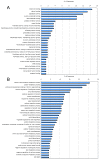Stage- and gender-specific proteomic analysis of Brugia malayi excretory-secretory products
- PMID: 18958170
- PMCID: PMC2569413
- DOI: 10.1371/journal.pntd.0000326
Stage- and gender-specific proteomic analysis of Brugia malayi excretory-secretory products
Abstract
Introduction: While we lack a complete understanding of the molecular mechanisms by which parasites establish and achieve protection from host immune responses, it is accepted that many of these processes are mediated by products, primarily proteins, released from the parasite. Parasitic nematodes occur in different life stages and anatomical compartments within the host. Little is known about the composition and variability of products released at different developmental stages and their contribution to parasite survival and progression of the infection.
Methodology/principal findings: To gain a deeper understanding on these aspects, we collected and analyzed through 1D-SDS PAGE and LC-MS/MS the Excretory-Secretory Products (ESP) of adult female, adult male and microfilariae of the filarial nematode Brugia malayi, one of the etiological agents of human lymphatic filariasis. This proteomic analysis led to the identification of 228 proteins. The list includes 76 proteins with unknown function as well as also proteins with potential immunoregulatory properties, such as protease inhibitors, cytokine homologues and carbohydrate-binding proteins. Larval and adult ESP differed in composition. Only 32 proteins were shared between all three stages/genders. Consistent with this observation, different gene ontology profiles were associated with the different ESP.
Conclusions/significance: A comparative analysis of the proteins released in vitro by different forms of a parasitic nematode dwelling in the same host is presented. The catalog of secreted proteins reflects different stage- and gender-specific related processes and different strategies of immune evasion, providing valuable insights on the contribution of each form of the parasite for establishing the host-parasite interaction.
Conflict of interest statement
The authors have declared that no competing interests exist.
Figures





Comment in
-
Filarial parasites in the postgenomic era.Expert Rev Anti Infect Ther. 2009 Mar;7(2):189-92. doi: 10.1586/14787210.7.2.189. Expert Rev Anti Infect Ther. 2009. PMID: 19254167
References
-
- Mak JW. Epidemiology of lymphatic filariasis. 1987. pp. 5–14. Ciba Foundation symposium. - PubMed
-
- WHO. Global program to eliminate Lymphatic filariasis. Wkly Epidemiol Rec. 2006;81:221–232. - PubMed
-
- Nutman TB, Kumaraswami V. Regulation of the immune response in lymphatic filariasis: Perspectives on acute and chronic infection with Wuchereria bancrofti in South India. Parasite Immunology. 2001;23:389–399. - PubMed
-
- Hoerauf A, Satoguina J, Saeftel M, Specht S. Immunomodulation by filarial nematodes. Parasite Immunology. 2005;27:417–429. - PubMed
-
- Semnani RT, Nutman TB. Toward an understanding of the interaction between filarial parasites and host antigen-presenting cells. Immunological Reviews. 2004;201:127–138. - PubMed
Publication types
MeSH terms
Substances
LinkOut - more resources
Full Text Sources
Other Literature Sources

